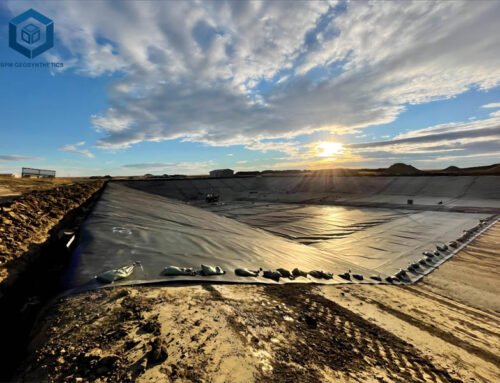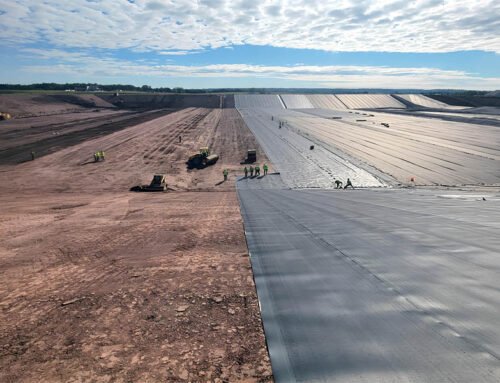When it comes to high-quality, durable, and cost-effective geomembrane solutions, HDPE liner for sale stands out as the premier choice for a wide range of applications, from landfill containment to aquaculture and mining. At BPM Geomembrane, we specialize in manufacturing and supplying top-grade HDPE liners designed to meet the highest industry standards. With years of expertise and a commitment to excellence, BPM Geomembrane is your trusted partner for reliable, environmentally friendly, and long-lasting lining solutions.In this ultimate guide, we’ll explore the benefits, applications, and key considerations when choosing an HDPE liner for sale, as well as why BPM Geomembrane should be your preferred supplier. Whether you need a custom-sized liner or expert advice, we’re here to provide the perfect solution for your project. Let’s dive in!
1. What is HDPE Liner?
HDPE liners are geomembranes made from high-density polyethylene, a thermoplastic polymer known for its strength, durability, and resistance to chemicals, UV radiation, and extreme temperatures. These liners are manufactured in sheets of varying thicknesses and are used to create impermeable barriers in a wide range of applications. HDPE liners are particularly popular because they are:
Durable: Resistant to punctures, tears, and environmental stressors.
Flexible: Can conform to uneven surfaces and withstand ground movement.
Chemically Resistant: Impervious to most acids, alkalis, and organic solvents.
Cost-Effective: Offers a long lifespan with minimal maintenance, reducing long-term costs.


2. Applications Of HDPE Liners
HDPE liners are used in a variety of industries and applications, including:
- Pond and Lake Liners: Used to create watertight barriers in decorative ponds, fish farms, and irrigation reservoirs.
- Landfill Liners: Prevent leachate from contaminating groundwater in waste disposal sites.
- Mining: Line tailings ponds and heap leach pads to contain harmful chemicals.
- Agriculture: Used in irrigation canals, silage pits, and manure storage.
- Industrial: Line secondary containment areas for chemical storage tanks and wastewater treatment facilities.
- Environmental Protection: Used in stormwater management systems and erosion control projects.
3. Key Factors to Consider When Buying an HDPE Liner For Sale
When shopping for an HDPE liner, several factors will influence your choice. Understanding these factors will help you select the right liner for your project and ensure optimal performance.
3.1 HDPE Liner For Sale – Thickness
The thickness of an HDPE liner is one of the most critical factors to consider. Thicker liners offer greater durability and resistance to punctures but may be more expensive and less flexible. Common thicknesses range from 0.2 mm to 3.0 mm.
- 0.2 mm to 1.0 mm: Suitable for lightweight applications such as decorative ponds or temporary containment.
- 1.0 mm to 2.0 mm: Ideal for medium-duty applications like agricultural ponds or small reservoirs.
- 2.0 mm to 3.0 mm: Best for heavy-duty applications such as landfills, mining, or industrial containment.
Choose a thickness that matches the demands of your project, considering factors like the type of material being contained, the weight of the load, and the potential for punctures.
3.2 HDPE Liner For Sale – Size and Dimensions
HDPE liners are available in rolls of varying widths and lengths. The size you need will depend on the area you need to cover. Most manufacturers offer custom sizes to fit specific project requirements.
- Width: Standard widths range from 5 to 12 meters, but custom widths are available.
- Length: Rolls can be manufactured in lengths of up to 100 meters or more.
Ensure you measure the area accurately and account for overlaps (typically 6 to 12 inches) when calculating the required liner size.
3.3 HDPE Liner For Sale – Material Quality
Not all HDPE liners are created equal. The quality of the raw materials used in manufacturing can significantly impact the liner’s performance and lifespan. Look for liners made from virgin HDPE resin, as recycled materials may compromise durability and chemical resistance.
- Virgin HDPE: Offers superior strength, flexibility, and resistance to environmental stressors.
- UV Stabilization: UV-stabilized HDPE liners are essential for outdoor applications to prevent degradation from sunlight exposure.
3.4. HDPE Liner For Sale – Chemical Resistance
HDPE liners are known for their excellent chemical resistance, but it’s essential to ensure the liner is compatible with the specific chemicals it will be exposed to. For example:
- Acids and Alkalis: HDPE liners are resistant to most acids and alkalis, making them suitable for industrial and mining applications.
- Organic Solvents: While HDPE is generally resistant to organic solvents, prolonged exposure to certain chemicals may require a specialized liner.
Consult the manufacturer’s chemical resistance chart to confirm compatibility with your application.
3.5 HDPE Liner For Sale – Installation Requirements
Proper installation is crucial for the performance of an HDPE liner. Consider the following factors:
- Subgrade Preparation: The surface beneath the liner must be smooth, free of sharp objects, and properly compacted to prevent punctures and ensure a tight fit.
- Seaming Methods: HDPE liners are typically joined using thermal fusion (heat welding) or extrusion welding. Ensure you have access to the necessary equipment and expertise.
- Anchoring: The liner must be securely anchored at the edges to prevent movement or uplift caused by wind or water pressure.
3.6 HDPE Liner For Sale – Environmental Factors
Environmental conditions such as temperature, UV exposure, and soil composition can affect the performance of an HDPE liner.
- Temperature: HDPE liners can withstand a wide range of temperatures, but extreme heat or cold may require specialized formulations.
- UV Exposure: For outdoor applications, choose a UV-stabilized liner to prevent degradation.
- Soil Composition: In areas with rocky or abrasive soil, consider using a geotextile underlay to protect the liner from punctures.
3.7 HDPE Liner For Sale – Cost
The cost of an HDPE liner depends on factors such as thickness, size, material quality, and customization. While it may be tempting to opt for a cheaper option, investing in a high-quality liner can save you money in the long run by reducing maintenance and replacement costs.
- Price Range: HDPE liners typically cost between 0.50mm and3.00mm per square meter, depending on the specifications.
- Customization: Custom sizes, thicknesses, and additives (e.g., UV stabilizers) may increase the cost.
4. Advantages of HDPE Liners
HDPE liners offer numerous advantages over other types of geomembranes, including:
- Durability: HDPE liners can last for decades with minimal maintenance, even in harsh environments.
- Flexibility: Their ability to conform to uneven surfaces makes them suitable for a wide range of applications.
- Chemical Resistance: HDPE liners are resistant to most chemicals, making them ideal for industrial and hazardous waste containment.
- Cost-Effectiveness: Their long lifespan and low maintenance requirements make them a cost-effective solution.
- Environmental Safety: HDPE liners are non-toxic and safe for use in applications involving potable water or food storage.


5. Disadvantages of HDPE Liners
While HDPE liners offer many benefits, they also have some limitations:
- Limited Flexibility in Cold Weather: HDPE liners can become less flexible in extremely cold temperatures, making installation more challenging.
- Susceptibility to Stress Cracking: Prolonged exposure to certain chemicals or mechanical stress can cause stress cracking.
- Installation Complexity: Proper installation requires specialized equipment and expertise, which can increase costs.
6. Installation Tips for HDPE Liners
Proper installation is key to maximizing the performance and lifespan of an HDPE liner. Follow these tips:
- Prepare the Subgrade: Remove sharp objects, rocks, and debris, and compact the soil to create a smooth, stable surface.
- Use a Geotextile Underlay: In areas with rocky or abrasive soil, a geotextile underlay can protect the liner from punctures.
- Seam Carefully: Use thermal fusion or extrusion welding to create strong, leak-proof seams.
- Anchor Securely: Anchor the liner at the edges using trenches, anchor bolts, or other methods to prevent movement.
- Inspect Regularly: After installation, inspect the liner for damage or leaks and address any issues promptly.
BPM Geomembrane
With 20 years of expertise, BPM Geomembrane is a leading HDPE liner manufacturer, producing smooth and textured geomembranes (0.2mm–3mm thick, 2m–10m wide). Standard widths (5.8m–8m) optimize shipping, while custom sizes (e.g., 3m) may cost more due to material waste. Our high-quality, durable HDPE liners are ideal for ponds, landfills, mining, and industrial containment.
Trust BPM for cost-effective, reliable solutions—contact us today for the perfect geomembrane for your project!





